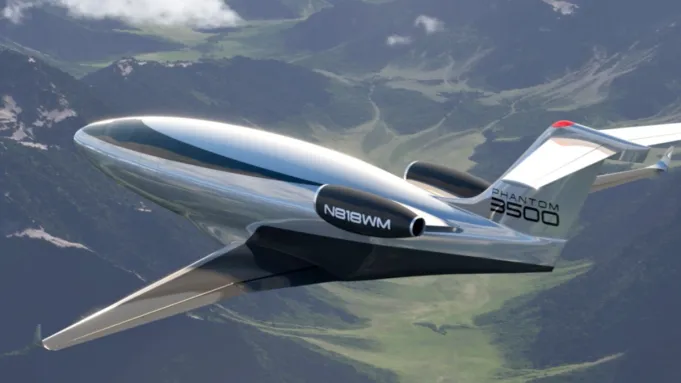
Otto Aerospace recently introduced a full-scale mockup of its Phantom 3500 to the market. The news of its formal launch at the UP.Summit in Bentonville, Arkansas, dovetails with an order by Flexjet, the world’s second-largest fractional-share firm, for 300 aircraft. At the unveiling, Flexjet chairman Kenn Ricci said the Phantom 3500 marks “a bold step into a future where an aircraft’s efficiency and sustainability stand alongside speed, comfort, and range as defining standards.”
The unusual, oblong Phantom is a clean-sheet twinjet design that looks like something out of a 1950s sci-fi movie. Its windows have been replaced by 72-inch digital screens, or what Otto calls SuperNatural Vision (SNV) technology, so passengers what passengers see come from cameras embedded along the exterior.
These lightweight screens add to the smooth, streamlined design of the laminar-flow airframe, engineered to minimize drag and improve fuel efficiency. The aircraft’s raked wings, carbon-fiber construction and smaller engines also combine to create a more efficient airframe.

The laminar flow design creates a much more efficient-flying aircraft.
Otto
“The laminar flow design also allowed us to reduce the aircraft weight by half compared to competitors like the Citation 10 or Praetor 500,” Scott Drennan, Otto’s chief operating officer, told Robb Report. “The design’s efficiency means that all the components can be reduced. The engines and wings are smaller, and the fuselage is also much lighter.”
Otto claims the Phantom 3500 will burn 60 percent less fuel than aircraft using current technology. It’s designed for a transatlantic range of 3,500 nautical miles and 51,000-foot ceiling. Its cabin will have headroom of 6’5”, considerably higher than most business jets. The first flight tests of the Phantom 3500 should happen in 2027, according to the company, with certification possible by 2030.
Otto CEO Paul Touw said in a statement that traditional jets rely on “derivative designs” based on traditional aluminum structures from previous decades. “Freed from legacy systems and guided by a true clean-sheet, ultra-efficient vision for the future, we rethink everything to unlock performance gains once thought impossible,” he said.

The side windows and overhead have been replaced by lightweight screens connected to exterior cameras.
Otto Aviation
Despite the vote of confidence by Flexjet, the Phantom 2500 has a long way to go. Otto is building a new 1,000,000-square-foot campus that includes a manufacturing facility, in Jacksonville, Florida., after receiving a $515 million incentive package from the state of Florida. Touw told ainonline.com that he envisions a “smart factory” with robotics, automation and deterministic assembly for the precision needed to create the laminar-flow aircraft.
Ricci said that the Phantom 3500 would be integrated into the Flexjet fleet, offering a more sustainable option. Flexjet or Otto did not reveal the financial terms of the agreement.
Authors
-

Michael Verdon
Aviation and Marine Editor
Michael Verdon is Robb Report’s Aviation and Marine Editor. Having been an editor at five national boating magazines, he has written about all sizes of boats. Verdon is also a lover of aircraft, from…
instagram:
Error: No feed with the ID 1 found.
Please go to the Instagram Feed settings page to create a feed.









